Friday, August 15, 1997
Awoke to a clear sunny sky and headed back into the Park. Stopped at Butte Lake overlook for good views of Yellowstone Lake with the Tetons in the distance.
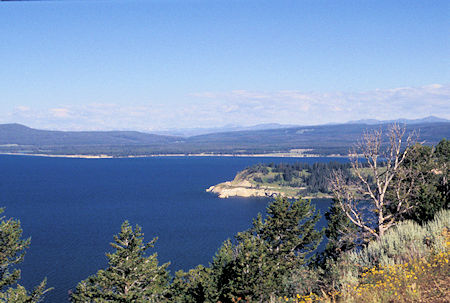
Yellowstone Lake from Butte Lake Overlook, Yellowstone National Park
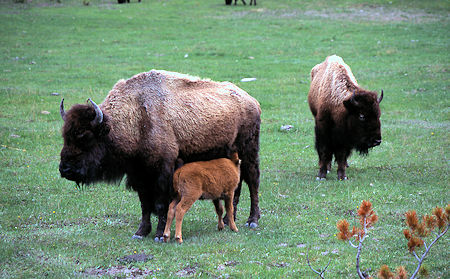
Buffalo cow and calf in Yellowstone National Park - National Park Service Photo
Stopped at the "Fishing Bridge" which is a spawning area for Cutthroat Trout which made it a great fishing hole.
The National Park Service decided that the heavy fishing was wiping out the trout species so closed it to fishing in the 70's.
The spawning was really over by now so didn't see any fish.
Pelicans also come to the area to fish. There was one here and I saw two more on the Yellowstone River later. They seem to just sit and float around until they see a fish.
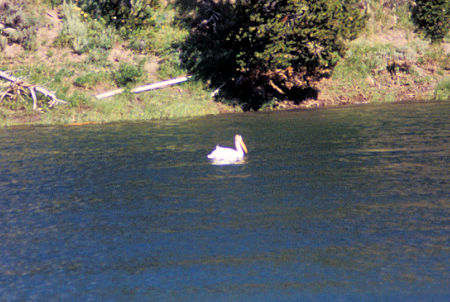
Pelican at Fishing Bridge, Yellowstone National Park
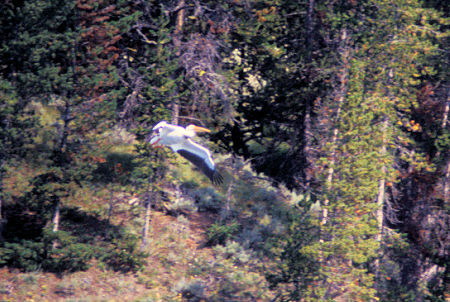
Pelican at Fishing Bridge, Yellowstone National Park
Drove the road between West Thumb and Canyon, hoping to see some buffalo. During the 1996-97 winter 1083 of the Park's buffalo had been slaughtered by the Montana Department of Livestock when they wandered out of the Park into the state. This slaughter plus a severe winter resulted in the loss of nearly two-thirds of the Parks buffalo herd so I wasn't surprised not to see any. The non-profit Buffalo Field Campaign organization has been fighting to protect the remaining buffalo. Visit their site for more information and how you can help.
I did see two different kinds of ducks and stopped at the Mud Volcano area and Sulphur Caldron.
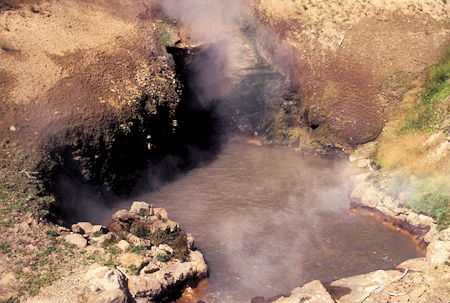
Dragons Mouth Spring (it belches), Mud Volcano area, Yellowstone National Park
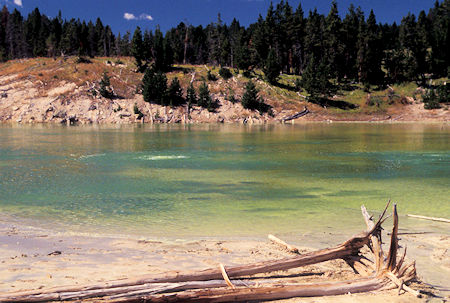
Sour Lake, Mud Volcano area, Yellowstone National Park
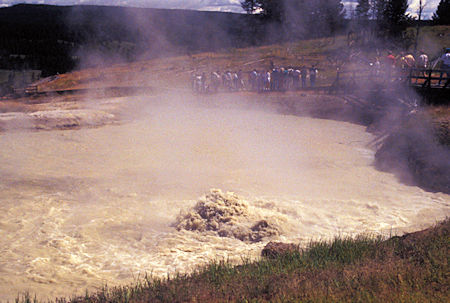
Churning Caldron, Mud Volcano area, Yellowstone National Park
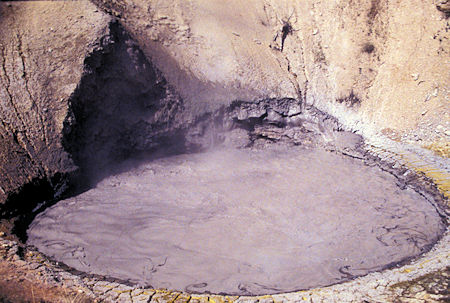
Mud Volcano, Mud Volcano area, Yellowstone National Park
Click for more Mud Volcano Area
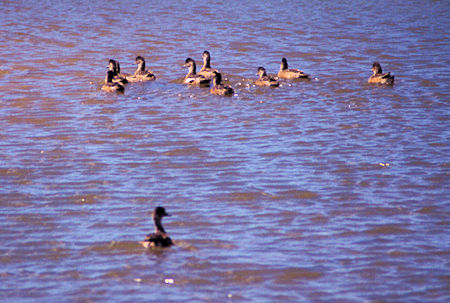
Ducks on Trout Creek, Hayden Valley, Yellowstone National Park
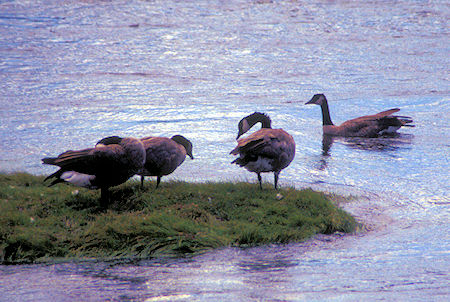
Ducks (or Geese) on Yellowstone River, Hayden Valley, Yellowstone National Park
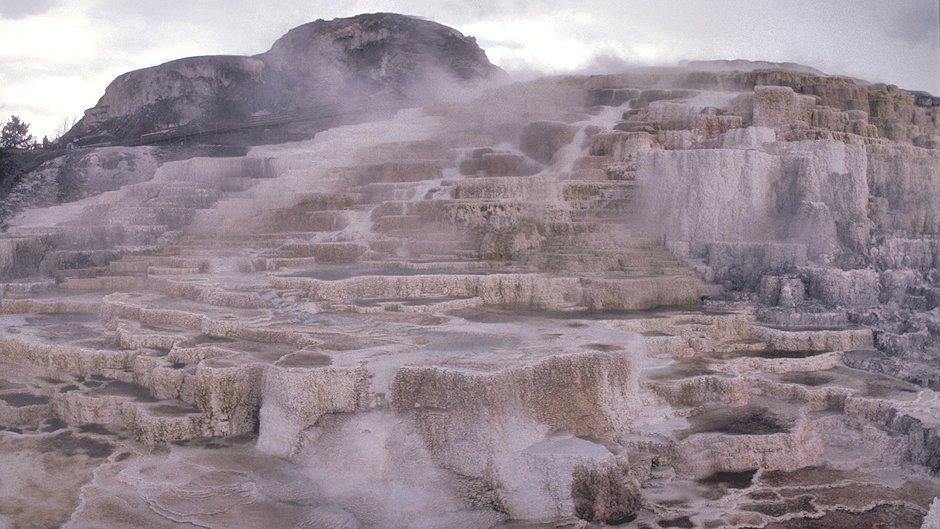
Minerva Terrace, Mammoth Hot Springs, Yellowstone National Park
From Canyon I headed west to Norris, then north to Mammoth Hot Springs - the original main entrance and current Park headquarters. Toured the interesting terraces formed here by hot springs. There were elk resting in two areas - apparently enjoying the heated ground. Around 3 p.m. the rain came back.
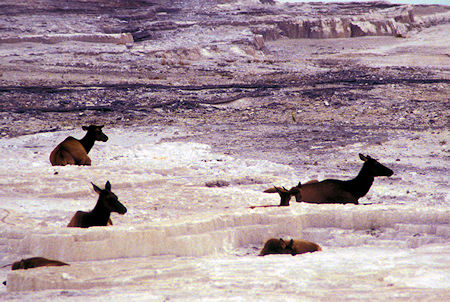
Elk resting on Mammoth Terrace, Mammoth Hot Springs, Yellowstone National Park
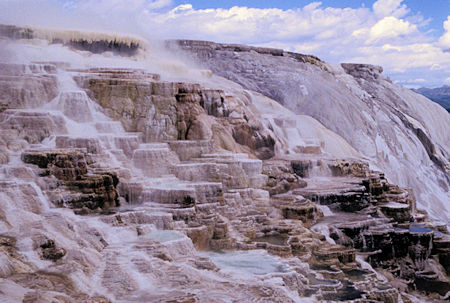
Minerva Terrace, Mammoth Hot Springs, Yellowstone National Park
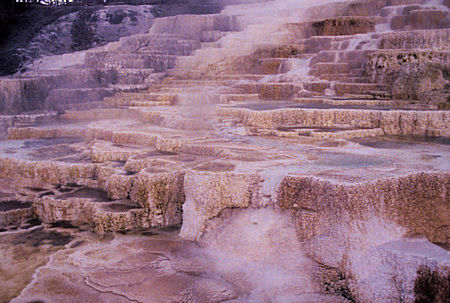
Minerva Terrace, Mammoth Hot Springs, Yellowstone National Park
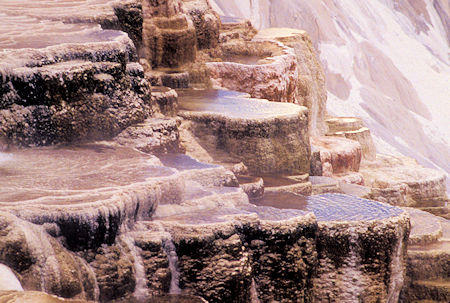
Canary Spring Terraces, Mammoth Hot Springs, Yellowstone National Park
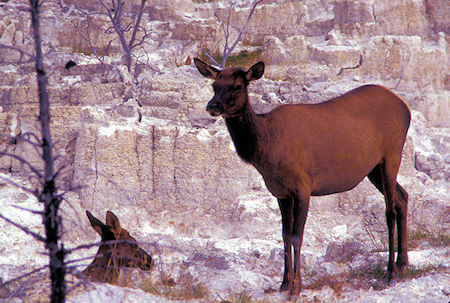
Elk near Canary Spring Terrace, Mammoth Hot Springs, Yellowstone National Park
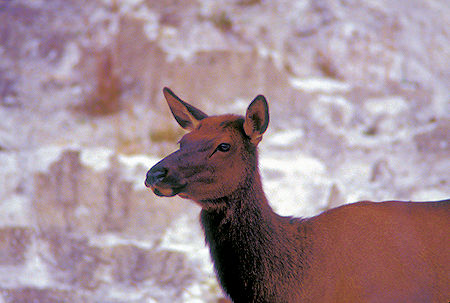
Elk near Canary Spring Terrace, Mammoth Hot Springs, Yellowstone National Park
Click for more Mammoth Hot Springs
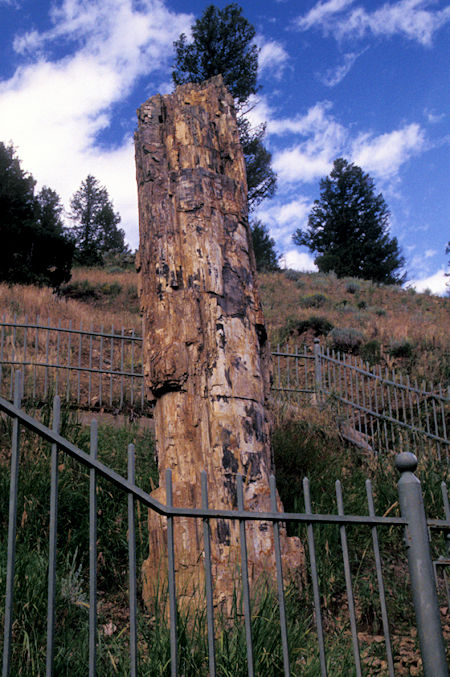
Petrified Tree, Tower-Roosevelt Junction area, Yellowstone National Park
Drove from Mammoth over to Tower and back just to see the area. Saw a single petrified tree that is still standing vertically. Saw another herd of elk next to the road.
Around 50 million years ago, scientists say this area of the park was flourishing with tall trees when volcanic eruptions buried the forest in ash.
Tucked away on a tall, dusty-brown dirt outcropping in the northeast corner of the park lies a natural attraction just waiting for passerby to take notice.
With a historical story to tell just as the parks other natural wonders do, Yellowstone’s petrified forest is a just as much look into the past as it is something to be admired in the present.
Around 50 million years ago, scientists say this area of the park was flourishing with tall redwood trees, maples, magnolias, oaks, dogwoods, and pines when volcanic eruptions from the nearby Absaroka Mountain range buried the forest in ash.
As the organic, woody material of the trees began to decay, silica-rich groundwater started to seep into the wood cells of the trees. This occurrence helped to preserve the buried forest by literally "freezing" the wood and halting their decomposition.
Meanwhile, the ash exposed on the surface slowly weathered into clay and the clay eventually weathered into soil that was suitable for new forest growth.
This cycle is thought to have taken 200 years – from old to new forest. It was a process, scientists say, that repeated itself for tens of thousands of years.
Glacial ice and the eroding power of running water and wind have uncovered the vast areas of fossil forests that visitors can see today. The Specimen Ridge site has 27 successive layers of forest – tree stumps that stand exposed, stratified from oldest to youngest as you make your way up the hillside. At the 3,400 foot high Specimen Creek formation, there are about 50 successive layers of exposed forest that can be seen.
Some of the oldest petrified trees uncovered by erosion in the park are up to 25 feet in diameter and count up to 1,000 tree rings.
Even more forest still lies fossilizing underground – an unseen natural wonder awaiting the attention of future visitors to Yellowstone.
Near Tower Junction was a GIANT TRAFFIC JAM. Seems someone had spotted a black bear (not grizzly). Some people just stopped in the road and abandoned their cars. A Park Ranger showed up and parked his car not entirely off the road which just made things worse.
I got through the jam going east and drove to Tower Falls hoping the campground might have room - nope, was full - so I returned west to the traffic jam. Parked off the road and got out to take a picture.
While walking back to my car I came to a big tour bus that was stuck because a large camper on the other side of the road was not far enough over to let the bus pass - that is the last two feet of the camper stuck out in front of the bus. This kept the traffic behind the bus from being able to move which kept the traffic in front of the camper from moving. I realized what the problem was and was able to get the two cars in front of the camper to move up enough to let the camper move up enough to let the bus past. One inch clearance between the bus mirrors and the camper but it cleared the jam.
It was now pretty much shower city as I headed north from Mammoth out of the Park and found the Canyon Campground, Gallatin National Forest - actually a minimal campground - no tables or fire rings - just one outhouse - but it was all I needed.
Saturday, August 16, 1997
It rained off and on all night and was rainy in the morning with heavy low clouds. About 9 a.m. it opened up to let a little sun come through as I headed north on US 89 to I 90 at Livingston, then I 90 to Bozeman, MT for a motel.


